
| [ Kuzma Stabi S Turntable ] |

In the last few months I have been receiving many personal e-mails and questions in the Audio Nirvana Forum about turntables. Many of you are coming again to the vinyl world and others are discovering for the first time this wonderful support for musical reproduction. Almost all of you left the vinyl when the CD began its life and now you realise how good a vinyl disc can sound. The birth of the CD meant a new media, in a single word, a very "convenient" storage device: durable, easy to store, with a good sound quality, etc. This convenience meant the substitution of the vinyl record in every shop and audiophile shelf and until now it hasn't been considered again as a excelent support for storing recordered music. Due to this demand of information I thougth that it would be useful for of all you to have some references about turntables. When I say references I mean two things: first, useful information to begin your way with vinyl and, specially, when buying a turntable, and second, from the point of view that the presented turntables are references among the others, I mean, machines that are above the others in terms of build quality and sound quality reproduction. With these two points in mind, and due to something more that happened some weeks ago, I write this article. My plans are to offer you more articles about the turntable issue in the next weeks and months.
What did happen some weeks ago?. It was a telephone call. Lluis Fabra from Classic Audio in Castellón (east coast of Spain), phoned me because he has some problems with his Quad ESL57 speakers. The phone call came in the rigth moment, when I was receiving all the e-mails and messages in the forum about turntables. I told Lluis what was happening because I knew that he is the Kuzma importer for Spain (I visited Lluis in his shop in the beginning of 2001) and I ask if it could be possible to have a Kuzma turntable in order to do an audition and to write the article you're reading. From the very first moment, Lluis showed his interest and after some e-mails he confirmed that I woud have a Kuzma Stabi S to do the audition. I have to thank the work of Lluis during all this time: sending the turntable, answering my questions and doubts, etc. And even when things got worse, when a spare transmission rubber belt was needed during the audition, he show what it is a good professional. That is exactly what we, the audio lovers, want from importers and dealers. A person who can help us in these "moments" when headaches come. You now what I mean. Now, I know that Lluis Fabra and Classic Audio are true professionals. Now, you also know that.
Before continuing with the article about the Kuzma Stabi S turntable, let me introduce some general points about the working principles of a turntable that will help you when purchasing these machines. The turntable is the only mechanical component of a hi-fi equipment. If we look at the electronic specifications of an amplifier or a CD before buying it, when buying a turntable we have to look at the mechanical qualities of the machine. The basic working principle of a turntable is quite simple: a big mass in rotation and a transducer (the cartridge) that reads the information stored in the record that is transmitted to the amplifier. But if we look in detail, this simplicity turns into complexity. First, let's point to the rotation movement. This rotation must be as stable as possible. This is achieved using a good motor that gives stable rotation. Ideally, but not really necessary, isolated from the main chassis to avoid unwanted vibrations that may affect the reading process and, in addition, the sound. The rotation also needs a good subplater wirh a perfectly machined axis and a good bearing for that axis. Also, a heavy platter, perfectly machined to avoid unstability and made from an inert material to avoid resonances. With these we resolve the rotation issue. Now we have the reading process. In this process two main part of the turntable are involved: the tonearm and the cartirdge. The tonearm must be rigid enough to prevent unwanted mechanical problems, its has to be build with precision (carefully machined, with bearings that allows precision in its movements) and it must have as many adjustable settings as possible (this will allow us to use it with several turntables if we decide, for instance, the upgrade path) . Usually the tonearms manufacturers offers a range of adapters in order to use the arm with differents turntables, so this isn't a problem, although we must verify this point and be sure that the seleted arm can be fittedin our turntable.
The cartridge is the next step. If we have achieved a good rotation and we can fit a good arm in our turntable we must select a cartirdge with equally good characteristics. The cartridge
reads the information stored in the disc groove and transmits it to the amplifier. We have to find a cartridge that fits, without problems, with our turntable and arm and also with our amplifier. It has to be able to extract all the information stored in the disc without problems. As you can see I'm talking about the amplifier because in fact the last step to look at is the phono section of our amp. We must know that the output voltage of a cartridge is very low (more or less, between 0,2 mV for a MC and 5 mV for a MM) and so the phono section (or phono preamp) of our amplifier must be able to raise this voltage to acceptable levels without distorsion or noises. My suggestion is, unless if the phono section of your amplifier is very good, to buy a dedicated phono preamplifier that will highly improve the quality of the musical reproduction.
Only one more thing based in my experince. Among all the other hi-fi equipment I own, the turntable is the only one that beneficts clearly from upgrading more than any other. A new interconnect, a better cartridge or a dedicated phono preamplifier is automatically reflected by a sound quality improvement, very much that with amplifiers or CD players. I guess that
these very low electrical signals benefits from any step done in order to improve its transmission.
As you know the turntable we are talking about it's a Kuzma, the Stabi S. I'm not going to talk about all the previous test made by the hi-fi journals (the journals we read and know) of this turnatble. And the fact the it has always get the best reviews. Nor about the fact that the Stabi has been listed for several years in the Stereophile list of recommended products and that it's highly considered in the USA market. No. But, let's point it clearly, all these facts gives us a reference about what we are talking about. But as I always say the best test is our ears. Listen and you'll see. That's what i have done.
Based in Slovenia, Kuzma builds high-end turntables since 1982. The company was founded by Frank Kuzma, as a result of his training as mechanical engineer and to his working experience with acoustic transducers, and started the production with the turntable we are talking about. From the beginning their products were very well welcome by the audiophiles and the specialized hi-fi press and the company become stablished in the hi-fi market.
The Kuzma Stabi S is the smallest turntable in the Kuzma range, although it look like as if it was the bigger. It is an unusual desing though to achieve the highest rigidity and stability. It hasn't any chassis, as it's usual in conventional turntables, but a big T shaped metal piece. This T is build from two solid metal cylinders that has been soldered together and is the main part of the turntable, the one that gives the stability and rigidity needed and also the responsible for isolating the whole turntable from vibrations with the help of rubber rings fitted as decoupling feet. To give you a closer idea of what I'm talking about, you have to know that this piece weigths 6 kg! In the main axis of the T there's the place where to fit the subplatter axis, a "hole" covered by plastic an textile materials to help the rotation (no bearings). In the opposite side of the T there's the arm's mounting adapter. It is a mobile metal part that allowas VTA adjustment independent from the arm (just in case the arm doesn't have this adjustment).
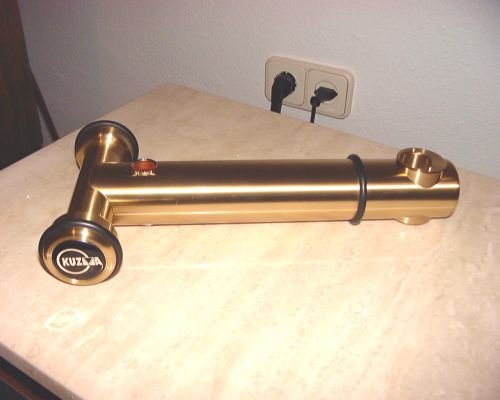

The subplatter is also made from metal and it is perfectly machined. The platter is made from metal and it has very good anti-resonant qualities. In its upper part (where we will place the record) it is covered by a rubber disc to improve damping of unwanted resonances. The turntable comes with a record clamp made from the same metal used to build the T and it can be installed on the platter to improve the stability of the whole unit and to level a bended disc in order to improve the reading process.
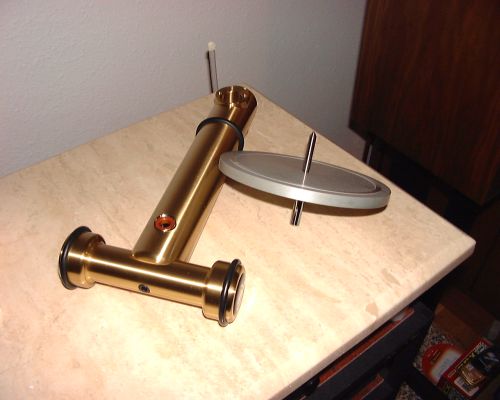

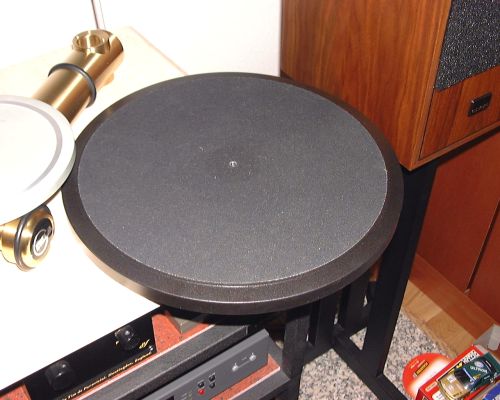
The turntable motor is separated from the turntable and it is fitted inside a special cilindrycal box. Due to this, no vibrations are transmited to the turntable. The rotation of the motor is transmited to the subplatter by means of a rubber belt. The engine has two speeds, 33 rpm and 45 rpm, and it can be changed using a set of adaptors. The arm that came with the turnatble was a Stogi S, an unipivot model, but SME and Rega arms can be used by the means of special adaptors. The working principle of the unipivot is curious and simple. As the name unipivot says, the arm rests on a single point. In fact the Stogi rests on that single point and inside a container filled with liquid silicone, that allows the arm to work properly and that also improves vibrations. The arm works perfectly. I just had a complaint with this arm. I wanted a handle to control the arm manually (rise it from the disc) but when asked this question to Lluis Fabra he told me that almost all the unipivot come without a handle because this device change the weigth simetry of the arm and doesn't allow a precise azimut adjust. Understood.
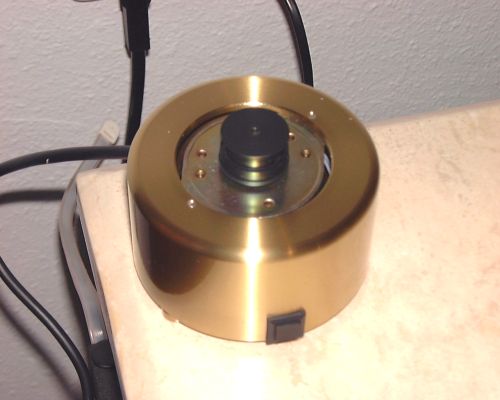




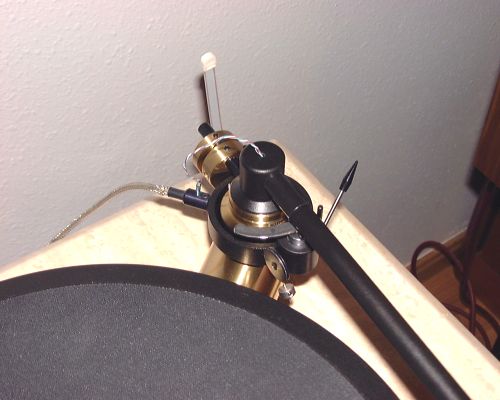
The turntable is delivered to the user dismanteled but the assembling process is easy following the assembling instructions. They would benefit from some images in order to ease the process. If you are affraid about what would happen if during the assembling process some parts are damaged, don't worry because every single part of the turntable can be purchased as an spare part. The cabling used in all the arm (interconnects and internal cabling) is a very good model from Cardas. I would recommend some additional things in order to get the best performance from the Stabi turntable. First, it is mandatory to have a heavy and rigid shelf or base where to place the turntable. The Stabi is a turtable without suspension and it need to be isolated from external vibration to avoid unwanted noises while playing records. A marble base will be a good example of rigid base from this turntable. Second, you will need a gauge to get the exacy tracking force applied to the cartridge because the arm hasn't any graduated scale to do that. Third, I would recommend a good cartridge. Classic Audio recommends some models from Ortofon (MC 30) and Goldring (Elite) but they have also tried some models from Benz Micro with success. But this is a personal choice. Finally, you will need a good phono preamplifier but this is also your choice.
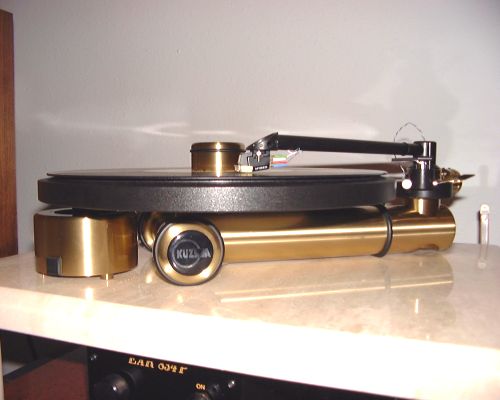
I had the tuntable for two weeks at home. I used my daily equipment to do the tests: Benz Micro Silver MC High Output (2 mV) cartridge, EAR 834P Signature phono preamplifier (NOS GE5751 tubes), Audiolab 8000C preamplifier, Audiolab 8000MX power amplifiers, Epos ES14 speakers, Cardas and Straigth Wire cables. Only for nostalgia reasons, it also was tested a Shure M97ED cartridge to see what happened . I'm going to tell you now.
The Kuzma, Benz Micro, Ear and Audiolab combination worked nicely. After the assembling process of the turntable (it takes more or less an hour) I began to listen to the music. Before my subjective opinions I must admit that I have some doubts about the behaviour of the arm. Its working principle is really curious because it only rest on a single point (unipivot). It is installed inside a liquid silicone container that acts as a vibration absorber and as stabilizer. I verified the behaviour of the arm before filling the container with the liquid silicone and I saw that the arm was very unstable. It moved in every possible direction and this made me worry. But after filling the container the arm acts as a common arm. No movements, good tracking ability. In fact liquid silicone has been used in tonearms for a long period of time. Some SME models (3009 and 3012) has a little container that can be fitted as an extra part, that must be filled with liquid silicone in order to improve the damping. The general behaviour of the turnable is very good. It starts rotating in 4 seconds and mantains the working speed perfectly. The arm follows the record precisely and the stop is soft.
The sound... as usual in turntables is so....nice. If you don't believe it, just try it. Except for the turntable, the equipment used is my usual hi-fi equipment. You know how difficult it is to describe an audition, always trying to find the exact word to explain that subjective impressions. The most adequate word to describe the sound is naturality. The Kuzma gave a natural sound. Soft, not fatiguing sound with soft non-agressive treble and controlled bass. As I said before no problems in the mechanical side, nor in sound. The Benz Micro Silver, the EAR (I love this preamp) and the Kuzma offered a deligthful sound. As I described before a Shure M97ED was used only to see what happened. It is a completely normal cartridge (some may say an ordinary cartridge) and I must confirm that the sound was obtained was thin and it showed how important a good cartridge is when talking about turntables. I could listen to the turntable for more than a week and I must admit that at the end I only listened to music, not to the equipment. This is the best thing that can happen when doing tests like that.
In conclusion, if you are thinking of purchasing a turnatble, please, take a look to the Kuzma. It has a high WAF factor, it is build to high standards (metal parts with an excelent finish), it sounds very good and the price is reasonable. The price of a Stabi S is 1231 €. The price of the Stogi S arm is 695 € (add the price of the cartridge you like). In addition to the model tested, Kuzma also offers more models. The Stabi SD that can be fitted with two arms and that has a price of 1484 €; the Stabi is1863 € and the PS version (external power supply) is 2747 €. The Stabi Reference with PS is 5842 € and the Stabi XL (by demand) 4650 €. The arms made by Kuzma are: Stogi for 1326 € and the Stogi Reference for 1958 € (all prives include VAT).
If I were you I wouldn't miss the chance to test a Kuzma.
Finally and again, thanks to Lluis Fabra from Classic Audio in Castellón for his kindly work during all the process of the test.
February 25th, 2002- Lluis Fabra from Classic Audio, the spanish importer of the Kuzma range of products, has sent information about the first phonograph cartridge made by Kuzma. It is the KC-REF, a MC cartridge, and below you can see an image and its specifications:
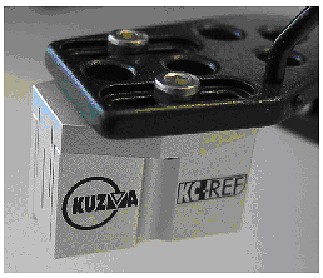
July 15th, 2002- Well...it seems that someboby read these pages. Directly from Mr. Frank Kuzma more explanations and some corrections to the errors I did when I wrote this article. Thank you very much Mr. Kuzma:
Hi,
I just saw your very nice review about our turntable Stabi S & Stogi S. Thanks. I just have a few technical clarifications for your information:
Best regards
Franc Kuzma